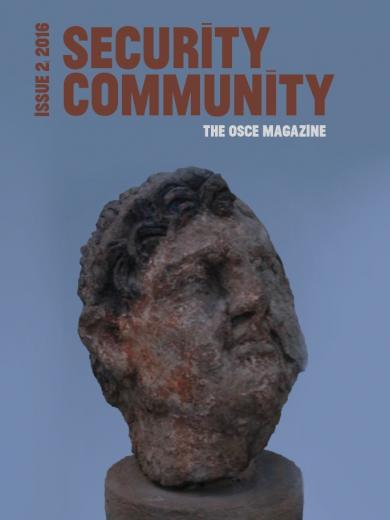Mission to Serbia: Roma Inclusion in Education
Support and continuity in the education of Roma children is crucial for the integration of the Roma national minority in Serbia. The percentage of Roma who completed primary education increased from 29 percent in 2002 to 33 percent in 2011. By contrast, only 11 percent had completed secondary school in 2011. The reasons for dropping out of secondary school are different for girls and for boys. Early marriage, economic hardship and community pressure are some of the main reasons Roma girls abandon school. Boys tend to quit to devote themselves full time to earning a living.
Valjevo in western Serbia is one city that has seen progress in Roma education, thanks to an ongoing € 4.8 million European Union-funded project, European Support for Roma Inclusion (ESRI), although issues of employment and housing, the two biggest problems facing the Roma community, remain. This was stated in January 2016 at the presentation of the work of joint mobile teams, which are part of the project. The teams are comprised of municipal Roma co-ordinators, pedagogical assistants, health mediators and representatives of social work centres and the national employment service. Valjevo is one of 20 pilot cities and municipalities in which mayors signed a memorandum of understanding in February 2014 to support them.
The broad composition of the mobile teams reflects the comprehensive, multi-component approach of ESRI. Under the slogan “We are Here Together”, the project is being implemented by the OSCE Mission to Serbia in co-ordination with the Serbian Office for Human and Minority Rights. It addresses the most persistent aspects of Roma exclusion ranging from lack of access to the most basic rights, such as adequate healthcare, education and welfare benefits, to difficulties entering the labour market.
For the OSCE Mission, the work on ESRI follows on ten years of work for Roma integration, notably in training pedagogical assistants and health mediators and supporting the co-ordination of municipal services. One of the persistent challenges the Mission has encountered is promoting co-ordination among the different institutions responsible for these programmes. Lloyd Tudyk, ESRI project manager at the OSCE Mission, explains that “when this large-scale project started, most of the interventions for Roma inclusion in Serbia had been based on one or two issues and tackled either only access to education or only unemployment. We’ve seen during these two years that the comprehensive approach is working.”
Petar Antic, an OSCE Mission advisor for the mobile teams, says that the results achieved in Valjevo are significant: “inter-agency co-operation is now much better, above all between the social work centre, the national employment service, schools, health facilities and the municipality.” Promoting the enrolment of Roma in schools is a core part of the mobile teams’ work. Thanks to their efforts, more than 1,200 Roma children were enrolled in pre-school education.
The Roma co-ordinator from Valjevo, Dejan Marinković, notes that if Roma are better educated, they might be given more of a chance by employers, which in turn would solve housing and many other problems. “Without education there is no work; no job, no flat; and without that there is no health care – this is the vicious circle we are trying to break," he says.
One component of ESRI is dedicated to preventing Roma secondary students from dropping out of school. During two school years, the programme awarded scholarships to 667 students whose grades were poor and who would therefore have been in danger of ending their education early. The programme was implemented by the Ministry of Education, Science and Technological Development, with the assistance of the OSCE Mission and the Roma Education Fund.
One hundred and ninety-one pedagogical assistants and 194 mentors made an important contribution to enhancing the participation of Roma in the education process. The pedagogical assistants, who earned certifications as part of the project, worked with Roma and non-Roma children primarily on academic matters. The mentors, also trained within the project, facilitated socialization and helped to solve personal and family problems of the students who received scholarships. “The goal is to provide continuity and quality education for these socially vulnerable children, teach respect for diversity, develop multicultural values and foster cultural identity,” pedagogical assistant Vojke Zorica Jovanovic says.
The drop-out prevention programme, which concluded in June 2016, will be carried forward by the Ministry of Education with the assistance of EU funding. The mobile teams will continue to work; in fact, there are plans to expand the network.
Investing in secondary education means giving poor and excluded children a more equal start in life. Not only is access to education a human right, enhancing it is also smart economics that raises long-term labour productivity and helps break the intergenerational cycle of poverty affecting Europe’s poorest and most vulnerable communities. The ESRI’s promotion of inclusive education, coupled with its comprehensive approach, is helping to boost the chances of many Roma children in Serbia.
This article was prepared by Liudmila Tsiklis, Intern at the Communication and Media Relations Section of the OSCE Secretariat, based on information provided by Lloyd Tudyk, ESRI project manager at the OSCE Mission to Serbia.
Welcome to Security Community
Security Community is the OSCE’s online space for expert analysis and personal perspectives on security issues.
The views expressed in the articles are those of the authors and do not necessarily reflect the official position of the OSCE and its participating States.


